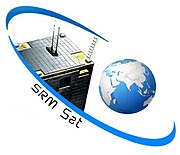SRMSAT
| Mission type | Technology |
|---|---|
| Operator | SRM Institute of Science and Technology |
| COSPAR ID | 2011-058D |
| SATCAT no. | 37841 |
| Website | www |
| Mission duration | 12 months (planned) 12 years, 6 months, 14 days (in progress) |
| Spacecraft properties | |
| Launch mass | 10 kilograms (22 lb) |
| Start of mission | |
| Launch date | 12 October 2011 |
| Rocket | FLP |
| Orbital parameters | |
| Reference system | Geocentric |
| Regime | Low Earth |
| Inclination | 20 degrees |
| Period | 102.1 minutes |

| |
SRMSAT is a
nanosatellite
was used to monitor Greenhouse gases in atmosphere.
SRMSAT's primary mission was the development of a
nanosatellite platform for future missions. Its secondary mission was monitoring of greenhouse gasses[1] using an Argus Spectrometer.[2]
Specifications
- It is a 10.4-kilogram (23 lb) spacecraft, which measures 28 centimetres (11 in) in length by 28 centimetres (11 in) in height and width.
- Its development programme cost around 1.5 crore rupee.
- It had a design life of one year, but is still working As of October 2017[update] and can be tracked easily on n2yo.com [3]
Launch
It was launched from the
Indian Space Research Organisation (ISRO)'s Satish Dhawan Space Centre at Sriharikota in October 2011.[4] atop a Polar Satellite Launch Vehicle (PSLV) C18 rocket. The launch was a multi-payload mission shared with Megha-Tropiques, VesselSat-1 and Jugnu.[5]
Parameters
SRMSATuplink at 145.9 MHz with a 1 kbit/s data rate. Attitude control is via solar cell management system (SCDM), an on-board magnetometer and Global Positioning System (GPS) receiver that provide data for magnetorquer coils which interact with the Earth's magnetosphere to change the satellite's orientation.[citation needed]
See also
References
- ^ "TN university plans centre for space technology". The Times of India. Archived from the original on 26 January 2013.
- ^ "Argus Infrared Spectrometers". Thoth Technology Inc. Archived from the original on 27 November 2013.
- ^ "LIVE REAL TIME SATELLITE TRACKING AND PREDICTIONS: SRMSAT". N2YO.com - Real Time Satellite Tracking and Predictions. Retrieved 28 October 2015.
- ^ "PSLV-C18 carrying weather satellite launched". Times Of India.
- ^ Subramanian, T. S. (12 October 2011). "PSLV-C18 puts four satellites in orbit". The Hindu. Retrieved 26 January 2012.
- ^ "SRMSAT". NASA.

